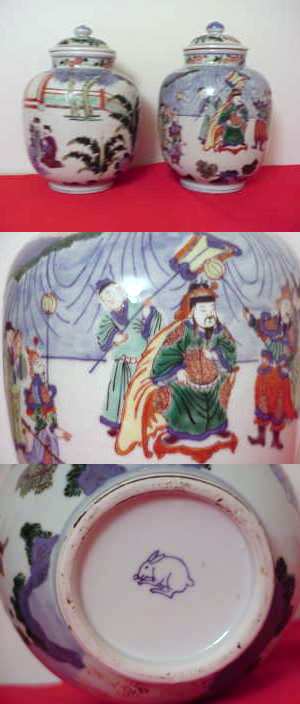
This page is only one of many thousands of Gotheborg.com Help and Information Pages, offering specialized knowledge on Chinese and Japanese Porcelain, including a Glossary, Q&A, Chinese and Japanese Porcelain Marks, Chinese Porcelain Exhibition and Excavation reports etc. For personal help and far more information, join our Discussion Board or use 'Ask a Question' for quick email consultations. For full text and better navigation, use a full-screen device rather than a mobile phone, that offers only limited content.
 I have a pair of well painted wucai jars and covers of compressed baluster shape, painted in enamels of brilliant tone with underglaze blue and overglaze red, green, yellow, and black.
I have a pair of well painted wucai jars and covers of compressed baluster shape, painted in enamels of brilliant tone with underglaze blue and overglaze red, green, yellow, and black.
The jars are encircled by a border of "cracked-ice" in underglaze blue on the shoulder, the domed cover decorated with dancing boys amid rocks. They bear a unique mark - a rabbit - on the bottom. Would you please give me your opinions about their age and value. Are they export or domestic pieces?
Jars of this shape were probably intended as wine jars or storage jars for preserved fruits and vegetables. Similar jars are today found in both early European collections, primarily Dutch, and I believe also in China, even if they are uncommon. If they were made for the export or the domestic market, is hard to tell. Probably both.
The mark is not that uncommon really, it is the "moon hare" which in Chinese mythology is "pounding the elixir of immortality on the Moon".
It occurs on late Ming pieces and on pieces from well into the early Qing dynasty, Kangxi period, which is also the period these jars could belong to. Specifically the "cracked-ice" border you are mentioning is a typical Kangxi (or later) feature and does not really occur earlier than that.
Regarding their authenticity, it is unfortunately impossibly for me to be certain by studying your pictures only. Their rounded shape is not entirely convincing but I can not rule them out on this ground only. Some smaller jars I have seen do have this shape.
To get an idea of their age you could make a preliminary investigation yourself.
The first thing to look for would be their weight. They should be "heavier then they look".
The second thing would be to look at their inside walls. Any jar this size should have been made in at least two horizontal sections, and then "glued" (luted) together with wet clay before firing. Traces of this should be clearly visibly from the inside.
The third sign of authenticity would be the absence of any solid black enamel. I feel that "black" on an 17th century jar should really be arrived at, by several layers of different colors - i.e. green glaze over a dark brown.
The rims should really also have some fritting. Any sign of broken glaze bubbles along the rim would be a good sign. Ok, some jars must have succeeded entirely without this feature, but their absence would raise a question.
Finally, I should mention that maybe the "hare" looks a bit too "cuddly" to me, to be a 17th century "Moon hare" with a serious intention to pound any "elixir of life" but, as I said, the final authentication must I believe be made by someone who can handle the jars.
If found authentic the value would be considerably, probably around $2,500 - 4,000 each depending on condition.
Thank you for your interest.
Best regards,
Jan-Erik Nilsson
This information is given as an example of private conversation only and is not intended to promote any individual piece. All opinions are the authors and are given as such with all hazards of judging anything from a photo. Copyright © Jan-Erik Nilsson, Göteborg 2000.
 Back to Chinese Porcelain Collectors Page
Back to Chinese Porcelain Collectors Page